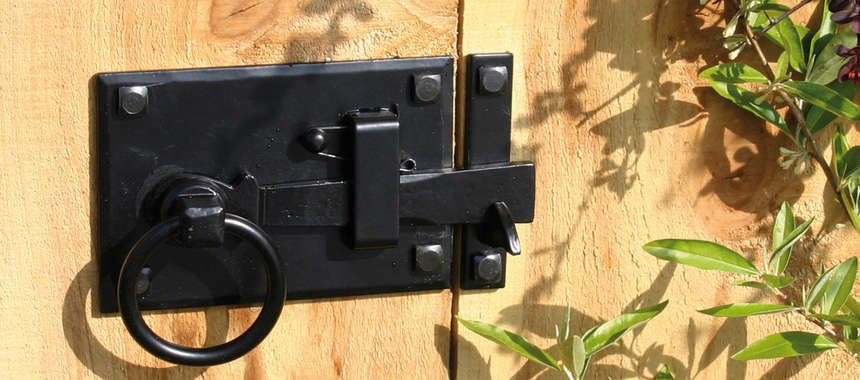
Curb appeal starts at the front gate. With the help of Jana Lombardi, founder of Portland, Oregon-based 360 Yardware, a retailer and manufacturer of high quality exterior hardware, we’re deconstructing the details of latches and other elements that can make your gate swing smoothly.
A hand-forged steel ring latch made by From the Anvil in Wales. At its simplest, a latch is a mechanism with a metal bar and lever that raises and lowers to open a gate.
What is a gate latch?
Lombardi stresses choosing with longevity in mind, paying particular attention to your geography when selecting materials and to quality workmanship to ensure reliability.
First, the big picture
Lombardi suggests first getting ideas on design and hardware websites, viewing gate builders’ online galleries, and looking around the neighborhood.
The Nero Contemporary Lever Gate Latch, designed and produced by 360 Yardware, coordinates with the numbers on this Portland home; $350. Next, look at the hardware on your front door: If you like the door handle, you may want to echo the look with a gate latch of a similar style.
What type of latch should I choose?
Thumb Latches
A traditional cast bronze Two-Sided Thumb Latch with a drop bar is $295 from 360 Yardware. Thumb latches are typically for in-swinging gates and are double sided, meaning they can open and close from either side of the gate.
From Sun Valley Bronze, a Gate Latch Privacy Set has two handles (one for each side of the gate), a bar latch with locking mechanism, receiver strike, and spindle. For more, see Made in the USA: The Ultimate Gate Latch.
Ring and Lever Latches
Ring latches also are two-sided and work on both in-swinging and out-swinging doors. The interior side has a backplate and ring, attached to a latch arm.
Lever latches mimic ring latches in function, except they have a lever handle instead of a ring.
The old-school bolt latch is another type to consider.
Bolt Latches
Tried and True
Then, of course, if you’re looking for something simple, functional and inexpensive, there’s always this tried-and-true fingertip release latch. Lombardi’s been known to recommend this straightforward solution in certain circumstances.
Home Depot sells a Galvanized Gate Latch for $7.14.
Lockability
Another variation in the ever-complicated gate latch hardware matrix concerns security. Two-sided lock options are the keyed deadbolt and the keypad deadbolt.
What materials are best for gate latches?
While mulling style and type, you’ll also need to consider material, which sets the tone for your color, finish and design. When choosing your material, Lombardi emphasizes keeping geography front and center.
Cast or wrought iron is the most common latch material on the market. Lombardi likes iron for homes in dry environments, where a rustic aesthetic is in order.
Iron
Stainless Steel
If you’re looking for a long-wearing, modern option, stainless is an excellent choice.
Stainless screams modern with this Alta Stainless Steel Contemporary Modern Gate Latch hardware set, $625 from 360 Yardware.
Looking for luxury and living at the coast?
Bronze
Most prevalent in the Northeastern U.S., brass latches tend to be a niche market.
Brass
Mild steel (steel mixed with a bit of carbon), copper, and high-tech polymers are other material options for gate latches, each with specific characteristics. Lombardi suggests those interested in custom work should first check out websites of local fabricators.
Specialty Materials and Custom Work
When it comes to installation, the devil really is in the details.
What do I need to know to install a gate latch?
Marin County fence builder George Salladin installed two stainless gate stops on this custom redwood gate.
Photograph courtesy of 360 Yardware.
Photograph by Marla Aufmuth for Gardenista.
A final note: pool latches
Many communities require that pool gates be childproof, which mean they must be self-closing (likely with a spring hinge) and too high for a child to reach.